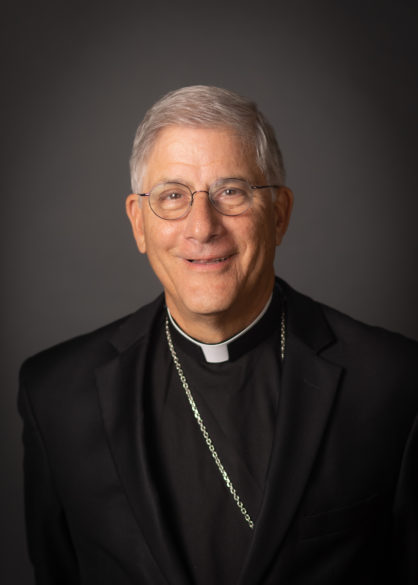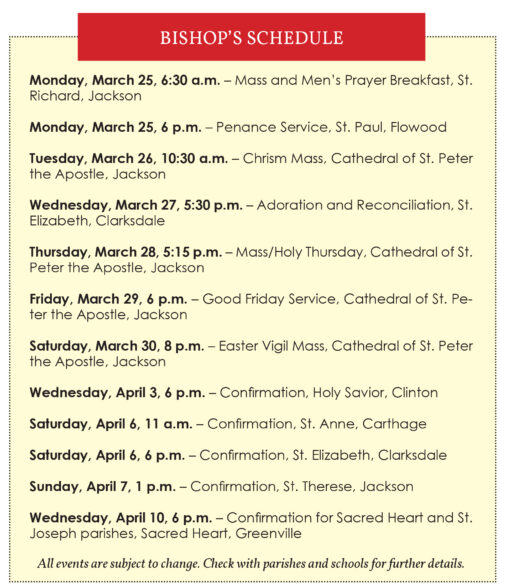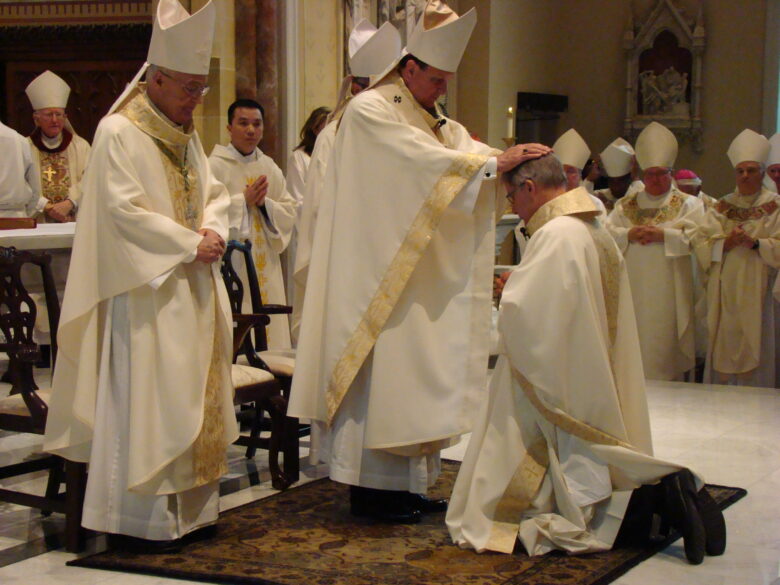
By Bishop Joseph R. Kopacz, D.D.
Lent arrives at its final stage with Palm Sunday and the beginning of Holy Week. It is an intensive time of accompanying the Lord Jesus in his passion and suffering, through his death, to the glory of the resurrection.
The uniqueness of the Palm Sunday Mass is found in the entrance rite with palm in hand, the procession, and the proclamation of the passion narrative. This year, the passion from the Gospel of Mark will resound throughout the Catholic world, and in a profoundly stark cry of forsakenness the Lord speaks for all of humanity. “My God, my God, why have you forsaken me.” (Mark 15:34) Between Palm Sunday and the Easter Vigil, the great majority of the faithful will be gathered at the outset of Holy Week to allow the Lord’s final hours and words to wash over them in the blood and water flowing from his side.
Chiara Lubich, the founder of the Focolare Movement expresses the great mystery of our forsaken Lord in this manner: “We contemplated in him the height of his love because it was the height of his suffering. What more could a God give us, that it seems that he forgets that he is God … Jesus converted the world with his words, with his example, with his preaching, but he transformed it when he provided the proof of his love, the Cross.”

Lubich and all who see the Lord with the eyes of faith are building upon the unshakeable foundation of St. Paul on the power of the Cross. “Indeed, the message of the Cross is foolishness to those who are perishing, but to us who are being saved it is the power of God … Jews demand signs, and Greeks look for wisdom, but we proclaim Christ crucified. This is a stumbling block to Jews and foolishness to Gentiles, but to those who are called, both Jews and Greeks, Christ is the power of God and the wisdom of God … For I resolved that while I was with you, I would know nothing except Jesus Christ, and him crucified … so that your faith might rest not on human wisdom but on the power of God.” (1Corinthians 1:18, 22-24; 2:2-5)
With his blood and with his cry, Jesus crucified and forsaken opened up all possibilities for this life including forgiveness, unity, justice, and peace, and eternal life to follow. It is true that all of humanity is in exile, but there are those whose forsakenness is extreme. During these most sacred days of faith, we are mindful of those in the Holy Land especially, but not exclusively, who are crucified and forsaken in war, destruction, death and displacement. These abandoned are more closely configured to our crucified Lord in their suffering.
Lubich offers this vision and hope: “Jesus forsaken is the most greatly pruned, whom neither heaven nor earth seemed to want … Because he had been uprooted from both earth and heaven, he brought into unity those who were cut off, those who were uprooted from God.”
Therefore, he and he alone is the way to reach beyond the barriers of hatred and violence toward the unity for which he prayed at the Last Supper, “that all may be one.” (John 17:22)
Again, from the wisdom of Lubich and the Focolare Movement we read: “This is everything, to love as he loved us, to the extent of his experiencing for our sake the sensation of being forsaken by his Father. Through Jesus, in fact, we gain by losing, we live by dying. The grain of wheat has to die in order to produce the ear of grain; we need to be pruned in order to bear good fruit. This is Jesus’ law, his paradox. The Holy Spirit is making us understand that in order to bring about Jesus’ prayer ‘may they all be one’ it is necessary to welcome Jesus forsaken in our disunity. Jesus forsaken is the road, the key, the secret.”
These are words of wisdom for us during Holy Week in the line of St. Paul. The Holy Spirit has inspired many in the Synodal and Reimagining processes in our diocese to address the need for greater healing and unity in our communities of faith.
The Holy Spirit is guiding us during Holy Week to look to Christ crucified and forsaken as the power and wisdom of God in whom all things are possible. The Holy Spirit who raised Jesus from the dead and who dwells within us through faith and baptism, will inspire to proclaim Alleluia on Easter Sunday because he is risen. But before we arrive at the empty tomb let the crucified and forsaken Lord wash us clean in his blood.










